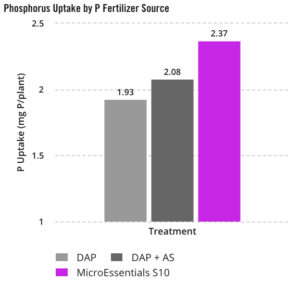OVERVIEW
- Balanced crop nutrition is critical for corn production.
- MicroEssentials® S10® supplies N, P and S in one nutritionally balanced granule.
- Two forms of S, sulfate sulfur (immediately available) and elemental sulfur (slowly available), provide season-long S availability.
- The MicroEssentials® proprietary Fusion® technology process creates a unique chemistry that results in increased nutrient uptake and crop yield compared to alternative sources.
TRIAL DETAILS
Locations and Crop Management:
Crop: Corn (Zea mays)
Year: 2013
Locations: SabancI University, Turkey
Data Source: Dr. Ismail Cakmak
Experimental Design: Pot trials conducted under greenhouse conditions on a clay loam soil.
Treatments: DAP (18-46-0), DAP + ammonium sulfate (21-0-0-24S), MicroEssentials® S10® (12-40-0-10S)
Study Details: All S in the blend was supplied in the sulfate form.
Fertilizers were homogeneously mixed with the soil, simulating broadcast incorporation.
Corn above-ground dry matter, P concentration and P uptake were determined 20 days after planting.
Results

SUMMARY
- MicroEssentials® S10® increased P uptake by 23% compared to the DAP and 14% compared to DAP + AS.
- MicroEssentials® S10® increased P uptake through increases in both plant dry matter (biomass) and P concentration (%).
- MicroEssentials® with Fusion® technology combines N, P and S into one nutritionally balanced granule and promotes improved P uptake.